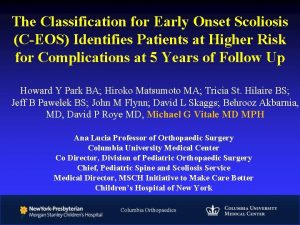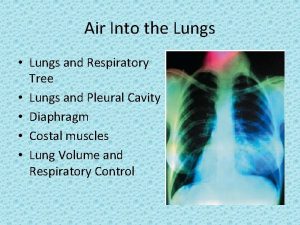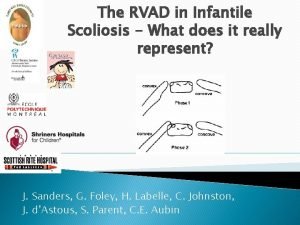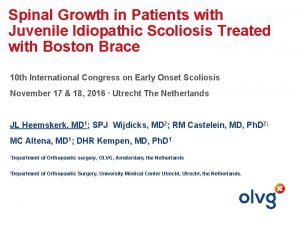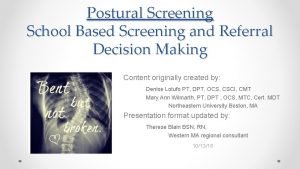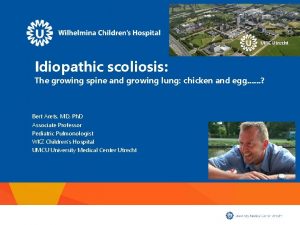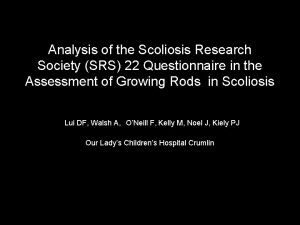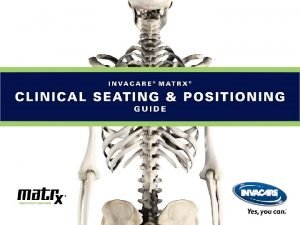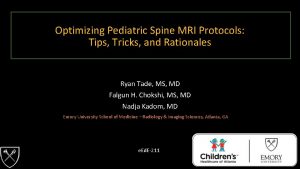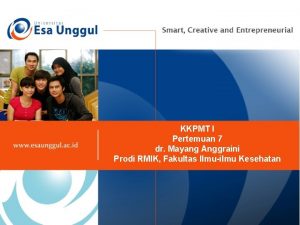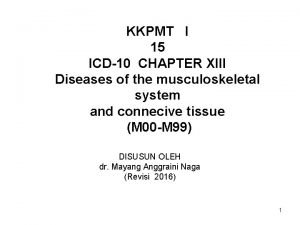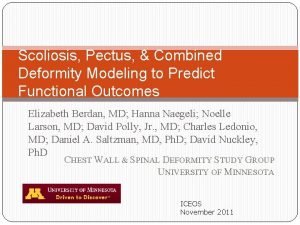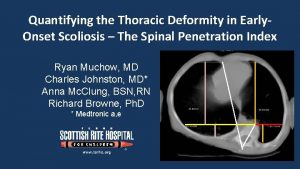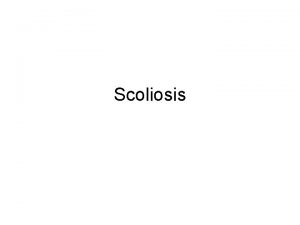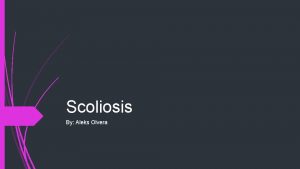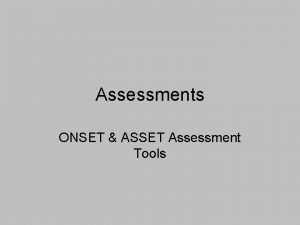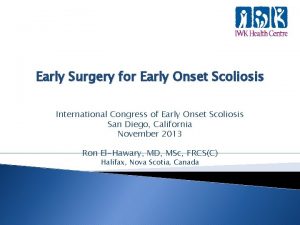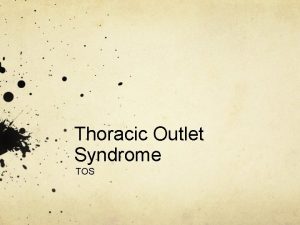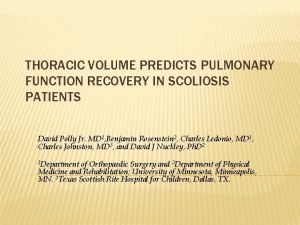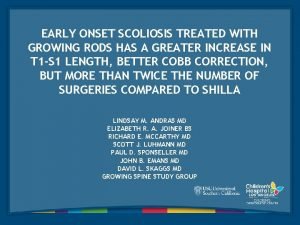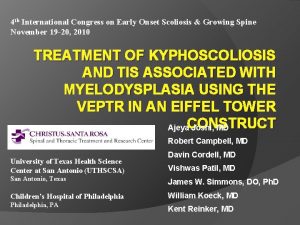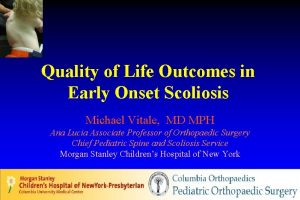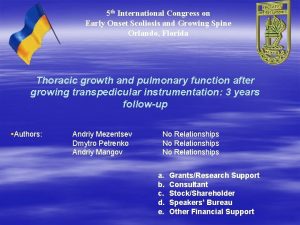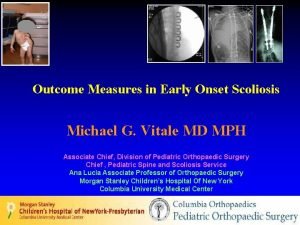Thoracic Volume Modeling in Early Onset Scoliosis David















- Slides: 15

Thoracic Volume Modeling in Early Onset Scoliosis David Matson, MS 21; Charles Ledonio, MD 2; David Polly Jr. , MD 2; Kristin England, MD 2; Jeff Pawelek, BS 4; and Behrooz Akbarnia, MD 3, 4 1 University of Minnesota Medical School; Minneapolis, MN. 2 Department of Orthopaedic Surgery, University of Minnesota Medical School; Minneapolis, MN. 3 Department of Orthopaedic Surgery, University of California, San Diego; San Diego, CA. 4 San Diego Center for Spinal Disorders; La Jolla, CA.

Disclosures • David Matson: no disclosures • Charles Ledonio, MD: – Grants/Research: Medtronic, Do. D, OREF • David Polly, Jr, MD: – Grants/Research: Do. D, OREF • Kristin England, MD: no disclosures • Jeffery Pawelek: no disclosures • Behrooz Akbarnia, MD: – – Grants/Research: De. Puy Spine Consulting: Ellipse, Kspine, K 2 M Ownership/Shareholder: Nuvasive, Ellipse, Kspine Royalty/Patent: De. Puy Spine, K 2 M

Background • Virtual thoracic volume modeling from plain radiographs has been used in the adolescent idiopathic scoliosis (AIS) and early onset scoliosis (EOS) populations. Thoracic volume from modeling correlates within 3 -4% of thoracic volume from CT scans. • Early onset scoliosis (EOS) ↓ thoracic volume and lung volume • For AIS patients with poor pulmonary function, the modeled 2 year post-op thoracic volume change is strongly correlated with the two year post-op pulmonary function test.

Virtual modeling of scoliotic deformity • • As coronal deformity (Cobb Angle) increases, thoracic volume decreases Cobb Angle >70⁰, sagittal deformity does not appear to impact thoracic volume (England)

Purpose • Objective: to assess thoracic volume change with growing rod interventions in patients with early onset scoliosis.

Methods • • • Retrospective case study of children 10 years of age and younger with diagnosis of EOS Convenience sample of 6 patients with EOS from Growing Spine Study Group Coronal and sagittal radiographs used to model thoracic volume

Methods • • Patients all underwent growing rod surgery with varying number of lengthening procedures for treatment of diagnosed early onset scoliosis Blender software (2. 71, open access) to create 3 D model from coronal and sagittal radiographs – ‘computationally deformed’ to match chest X-rays • 3 D models created with pre- and post-operative radiographs – Post-op taken from midpoint of treatment and final lengthening – Up to 3 models per patient • Thoracic volume determined from models in Blender


Results Ø Pre-op thoracic volume = 1384 -2943 cc Ø Thoracic volume increased 19 -62% over the course of treatment Ø Pre-op major curve (Cobb angle) = 42 -87° Ø Cobb angle corrected 13 -71% over the course of treatment

Percent change in thoracic volume with growing rod treatment in EOS 70% 61% 3357 cc Cobb 22° 60% 62% 2240 cc Cobb 36° 50% 36% 1886 cc Cobb 38° 40% 30% 20% Baseline Thoracic Volume Case 1: 1384 cc Case 2: 1510 cc Case 3: 1699 cc Case 4: 2079 cc Case 5: 2182 cc Case 6: 2943 cc 33% 2001 cc Cobb 76° Case 2 30% 4004 cc Cobb 12° 19% 2023 cc Cobb 47° 10% 2391 cc Cobb 47° 2% 1729 cc Cobb 47° 0% Post L 1 Case 4 Case 6 27% 2766 cc Cobb 68° 5% 3088 cc Cobb 53° Pre Index Case 3 Case 5 2% 2111 cc Cobb 26° 10% Case 1 Post L 2 Post L 3 Post L 4 Post L 5 Post L 6 Post L 7 Post L 8 Post L 9 Post L 10 Post Fusion

Correlational Findings: Thoracic Volume Ø Strong correlation with T 1 -T 12 thoracic height (r = 0. 85, 95% CI: 0. 94, 0. 62) Ø Moderate inverse correlation with Cobb angle (r = -0. 59, 95% CI: -0. 84, 0. 16) Ø Moderate inverse correlation with kyphosis (r = -0. 53, 95% CI: -0. 81, -0. 07) Ø All correlations statistically significant (p<0. 05)

Correlational Findings Coronal T 1 -T 12 Cobb Angle Kyphosis 300, 0 100 90 250, 0 r = 0. 85 80 70 60 150, 0 50 40 100, 0 30 r = -0. 59 20 50, 0 r = -0. 53 10 0, 0 0 500 1000 1500 2000 2500 Thoracic Volume 3000 3500 4000 0 4500 Degrees Coronal T 1 -T 12 (mm) 200, 0

Conclusion • Growing rod technique effectively increases thoracic volume with subsequent lengthenings • Increased thoracic space for lung expansion during child growth • Changes in thoracic volume correlate significantly with other markers such as thoracic height, Cobb angle, and kyphosis

Discussion Ø Alternative assessment of spinal deformity and thoracic volume to CT scan, reducing radiation exposure to pediatric patients Ø Quantitative analysis and comparison of techniques used to treat EOS and other chest wall and spinal deformities Ø May prompt earlier intervention in pediatric patients with severely compromised volume when used as an alternative assessment to pulmonary function testing Ø Surgical intervention simulations with patient-specific models may improve pre-op planning and inform treatment decisions

Thank You!
 Early onset scoliosis classification
Early onset scoliosis classification Volume of thoracic cavity
Volume of thoracic cavity Helen c erickson
Helen c erickson Relational modeling vs dimensional modeling
Relational modeling vs dimensional modeling Rvad scoliosis
Rvad scoliosis Scoliosis chiropractor seminole county
Scoliosis chiropractor seminole county Risser score scoliosis
Risser score scoliosis Scoliosis
Scoliosis Scoliosis research society
Scoliosis research society Wheelchair backrest for scoliosis
Wheelchair backrest for scoliosis Mri scoliosis protocol
Mri scoliosis protocol Disorder of synovium and tendon
Disorder of synovium and tendon Thoracogenic scoliosis of thoracolumbar region
Thoracogenic scoliosis of thoracolumbar region Infantile scoliosis casting
Infantile scoliosis casting Scoliosis advisor
Scoliosis advisor Rib hump scoliosis
Rib hump scoliosis
